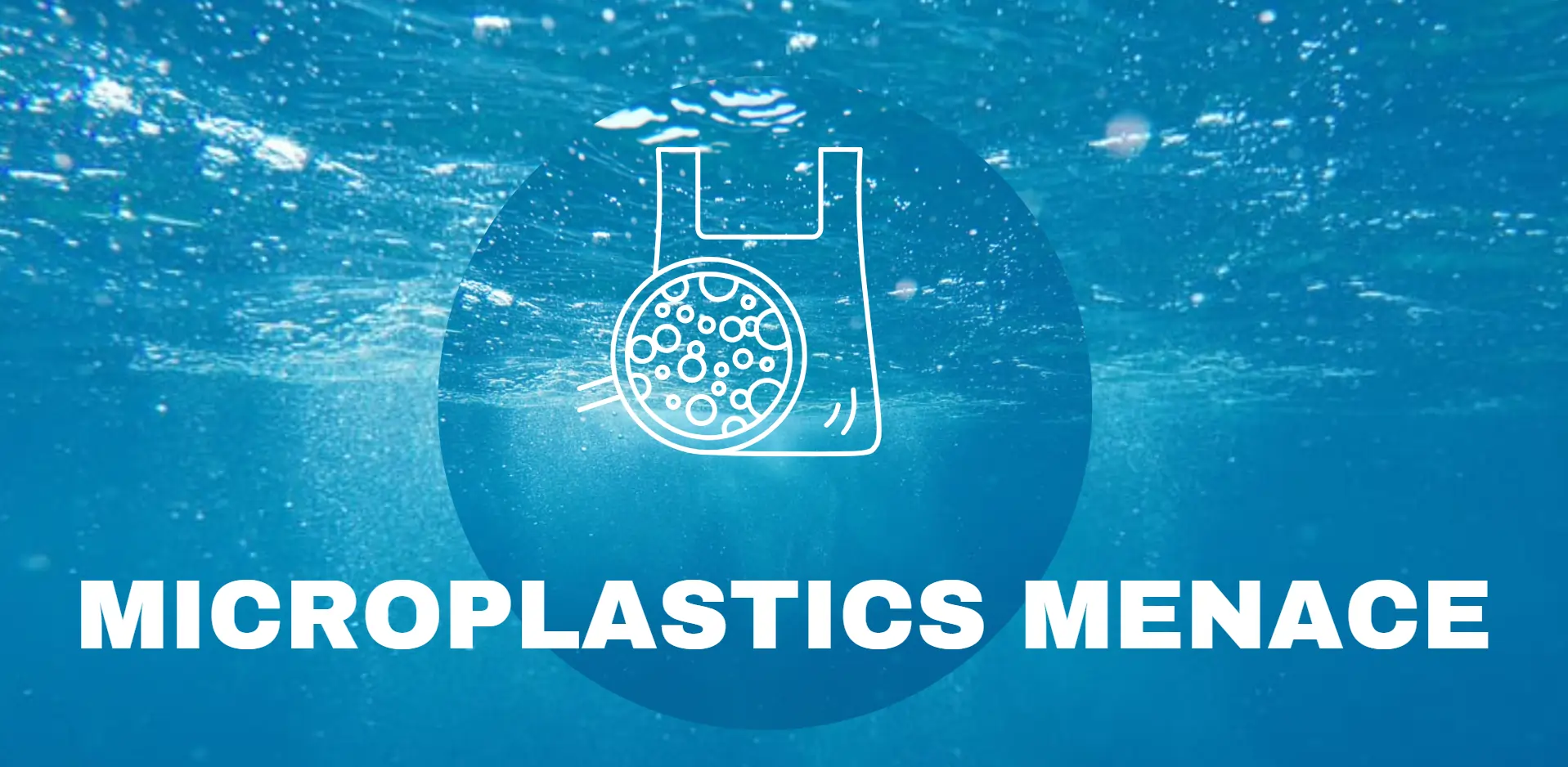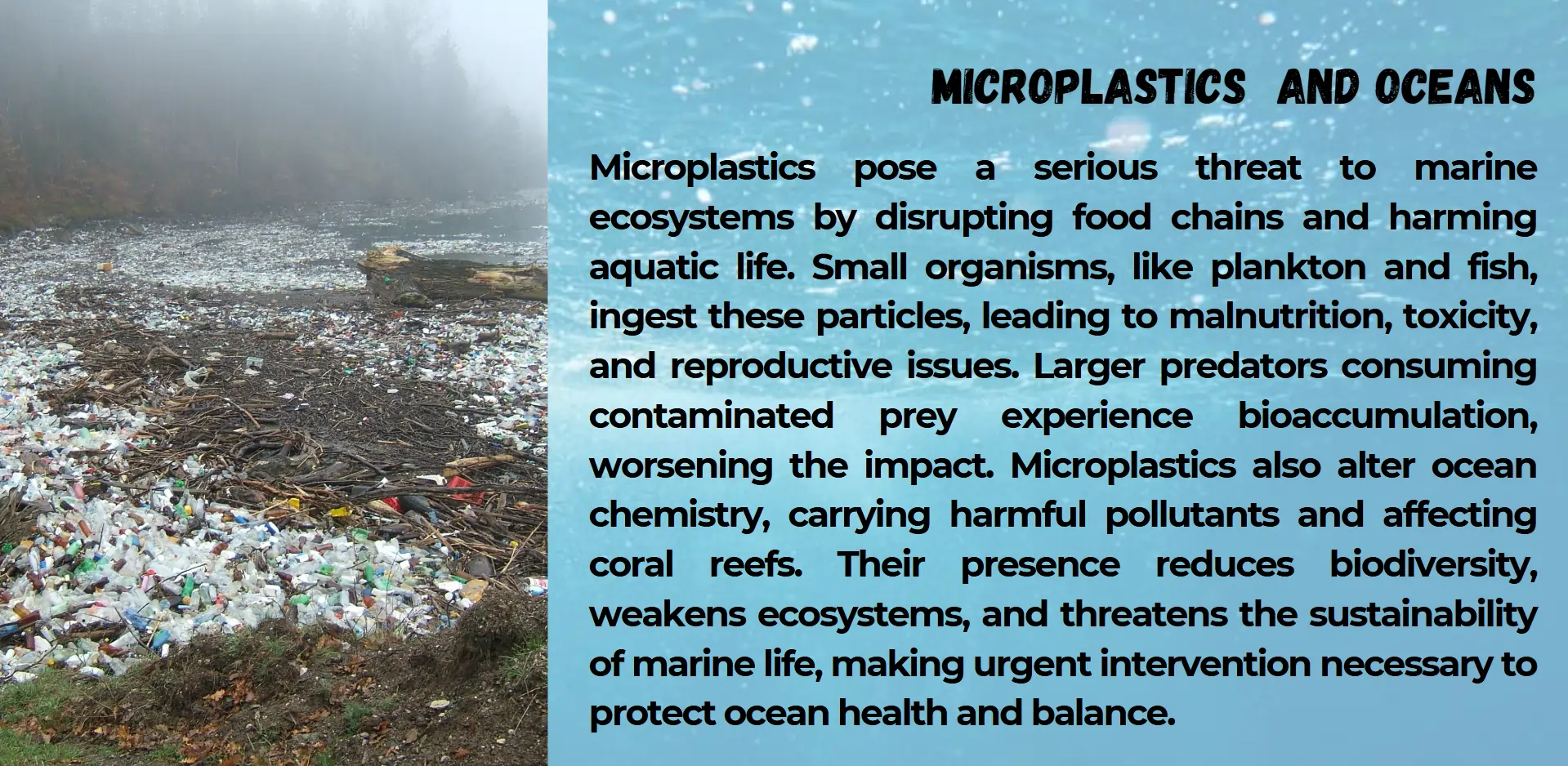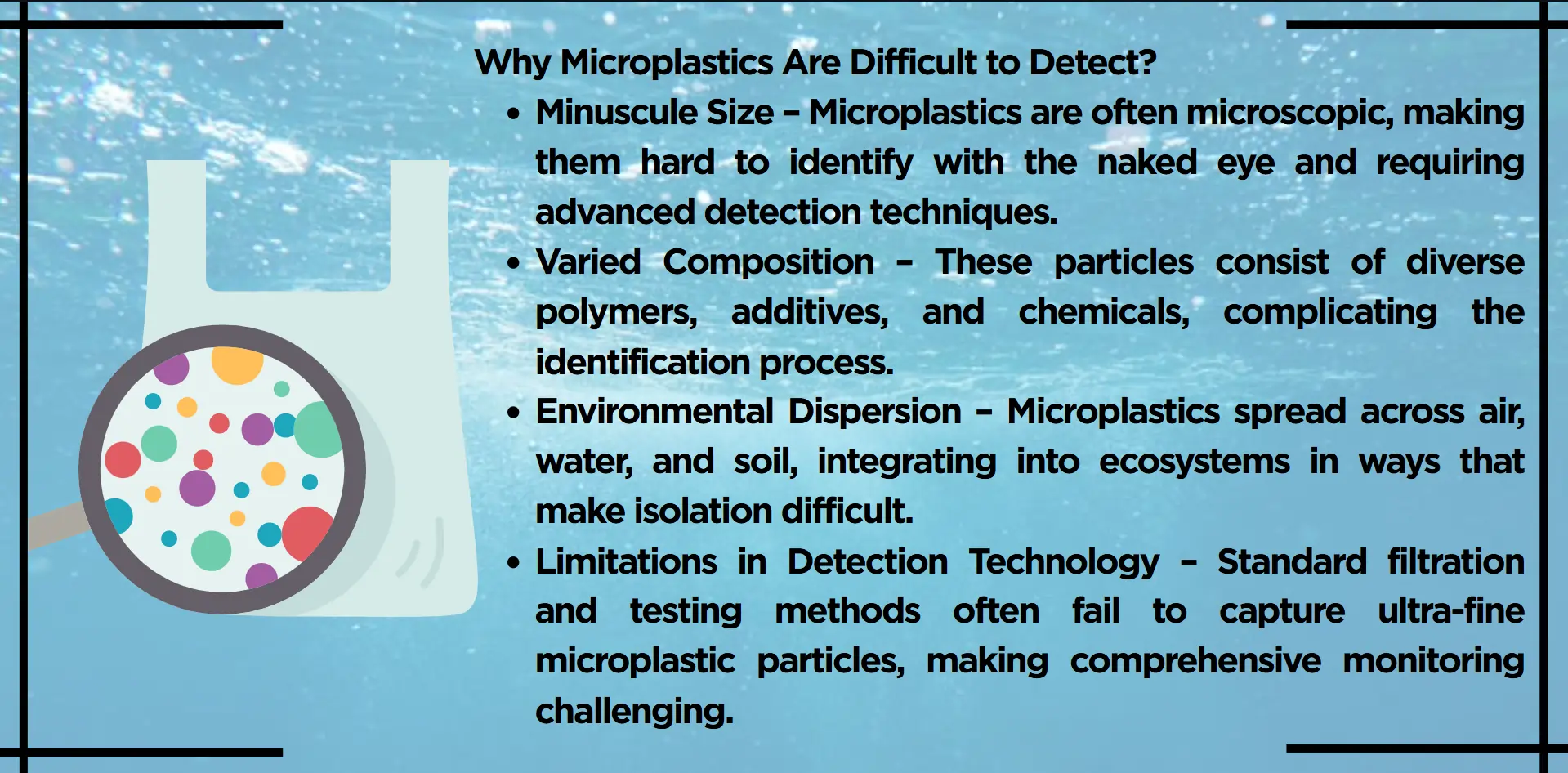The article presents an examination of microplastics starting from their origins until their effects on the environment and health together with their worldwide distribution while evaluating management difficulties and novel solutions alongside the necessity of united efforts to fight this expanding environmental issue.

Scientists have identified microplastics as an all-encompassing harmful substance which poses severe dangers to both ecological systems and human wellness. As the world celebrated plastic for its industrial and everyday life revolution the substance left behind hazardous components that now endanger our planet worldwide. Similar particles that stem from discarded packaging, synthetic textiles and industrial waste enter into all types of environmental materials including soil, air, and water. Microscopic plastic particles exist throughout every part of Earth extending from underwater ocean depths to the tallest mountain peaks alongside human water and food sources. Their extremely small size bypasses current waste management strategies thus producing an inconspicuous environmental emergency. The discovery of marine life, food chain and health threats from microplastics increases the necessity for immediate action regarding this environmental threat. The research investigates how microplastics emerge in the environment as it looks at their findings alongside action proposals to stop this escalating environmental issue.
Sources of Microplastics
There are two different groups that contribute to the widespread origin of microplastics: primary and secondary categories. The intentional manufacturing process produces primary microplastics for various purposes which includes Microbeads present in exfoliating skincare items alongside cleaning agents. Synthetic textile products contribute significantly to water pollution when fibers detach from normal washing which then enter the water supply systems. Industrial manufacturing operations that produce plastic pellets make primary microplastics appear in the environment. The decomposition of extensive plastic objects such as bottles, bags and fishing nets produces secondary microplastics. The separation of items into smaller fragments results from subjecting them to sunlight exposure as well as weather and mechanical wear. Natural degradation turns single-use plastic products into small fragments which can stay in the environment for numerous decades continuing to pollute.
The breaking down of tires through usage represents another serious origin of pollution. When vehicles move on the road they produce small synthetic rubber particles that eventually reach waterways through the water that accumulates during rain showers. Plastic materials pollute microscopic levels by losing flaked overlapping layers of paints and coatings from surfaces. Microplastics exist everywhere because they get into the environment through wastewater systems and contaminated landfills as well as actions performed by humans. The minute size of these particles makes detection and elimination difficult showing the necessity to stop plastic manufacturing and polluting at their origin.
Environmental Impact of Microplastics
- Marine organisms consume microplastics as food without recognizing their actual identity. Marine organisms mistake microplastics for food which leads to three harmful outcomes including physical damage, malnutrition and toxicity throughout the entire marine food web.
- Long-term contact with microplastics causes multiple aquatic species to experience decreased fertility and death rates thus endangering both biodiversity and ecosystem stability.
- Soil contamination by microplastics which mainly originates from fertilizers and wastewater sludge results in damaged soil structure and decreased water retention capacity as well as detrimental impacts on earthworm populations.
- The process of human activities including road abrasion and industrial operations results in microplastics becoming airborne. The process of settlement within different ecosystems results in environmental harm from these particles.
- The toxic additives phthalates along with bisphenols exist inside microplastics. Harmful chemicals gradually escape from these environmental particles when they enter ecosystems to thereby contaminate soil and water.
- Invasive species as well as pathogens transport across ecosystems due to their attachment to microplastics that function as carriers which contribute to disruptions of ecological balance.
- The bioaccumulation of microplastics in marine life leads them to higher trophic levels and potentially reaches humans at all stages of life and causes health risks to wildlife populations and people alike.
Microplastics pollution requires immediate global action to implement sustainable practices because of their extensive environmental effects.

Human Health Risks of Microplastics
- Microplastics enter the human body through the ingestion of food and water because they contaminate all forms of consumable water and seafood alongside agricultural products. Having particles in the diet leads to the ingestion of dangerous substances in the human body.
- Air transportation of tiny plastic particles poses breathing risks in polluted metropolitan regions adjacent to industrial regions which results in respiratory symptoms and possible lung injuries.
- Microplastic chemicals infiltrate human bodily systems leading to disorders of the endocrine system along with hormonal irregularities and various health problems.
- Scientific evidence demonstrates that accumulated microplastics lead to tissue and cellular inflammation which increases the potential for developing chronic diseases throughout time.
- Due to their persistence microplastics accumulate in body organs which threaten healthy operation of vital organs including the digestive system and those of circulation. Unknown long-term effects are possible because of the accumulated amount.
- The prolonged impact of additive chemicals in microplastics poses potential carcinogenic risks because these chemicals demonstrate cancer-causing characteristics.
- Microplastics cause disturbances to the gut microbiome that serves essential functions of immunity and digestion which results in gastrointestinal problems.
Analyzing the health effects of microplastics requires immediate focus since they exist throughout our environment.
Global Distribution of Microplastics
Microplastics exist as a widespread global environmental threat that has penetrated all ecosystems worldwide. From the deepest reaches of the oceans to the icy Arctic, microplastics have spread throughout the entire planet. The extensive spread of microplastics results from human-made sources as well as environmental transportation methods and their strong lightweight components. Most microplastics in the world accumulate within oceans. The movement of plastic waste through rivers and stormwater drainage systems enables them to reach near coastal zones before ocean currents spread out their composition. Ocean gyres contain high levels of microplastics according to research because these plastic particles form big floating waste clusters such as the Great Pacific Garbage Patch.
The availability of microplastics in terrestrial environments occurs due to fertilizer spread and compost applications as well as wastewater sludge additions to agricultural soils. Particulate matter is dispersed by wind and precipitation until it reaches locations miles from the coastlines including distant mountain peaks including the Himalayas. Microplastics in airborne form demonstrate extensive aerial dispersion because scientists detected them in both city and countryside areas as well as Polar Regions. Research shows that microplastics exist inside drinking water and packaged food items and they can also settle down through atmospheric fallout. The current worrying distribution of microplastics proves that global authorities must create new effective sustainable approaches to protect the planet's ecosystems.
Challenges in Managing Microplastics
The management of microplastics becomes complex because they measure tiny sizes and have many chemical compositions while existing globally across environments thus making detection and removal and regulation operations extremely complex.
Detection Difficulties
Standard detection equipment operates with limitations when it comes to identifying microplastics because these particles measure smaller than its operational range. Proper methods involving spectroscopy and microscopy fail to reach many parts of the world because they require expensive equipment. The many various chemical structures present in microplastics make it especially challenging to identify these particles.

Environmental Persistence
Microplastics resist complete breakdown because of their resistance to decay. Such resilient materials cling to remain in ecosystems throughout multiple decades which make clean-up work substandard as well as impractical in the long term. Developing knowledge about environmental behaviour presents the necessary solution for solving this problem.
Inadequate Waste Management Systems
Waste management methods today lack the ability to filter microplastics effectively from our environment. The current recycling and disposal systems cannot catch micro-particles passing through waste channels especially when these particles stem from synthetic textiles and tire wear.
Lack of Global Regulations
Worldwide policies about microplastic contamination need significant improvement. Current plastic waste regulations neglect to address microplastics because they concentrate on large plastic objects. Standardization of international laws and frameworks represents the key solution for this problem.
Technological Barriers
The deployment of innovative solutions through filtration systems alongside biodegradable plastics encounters practical difficulties as well as economic obstacles. Countries with developing economies find it difficult to implement these modern technologies which lead to worsening the local impact of the problem.
Public Awareness and Participation
The increasing menace of the problem has not compelled people to acquire adequate awareness about it. Cognition about their role in creating microplastic pollution remains underestimated for most people who partake in daily activities which include laundering synthetic fabrics along with employing disposable plastic products.
A comprehensive solution to the spread of microplastics needs joint work between technology experts, legal authorities, public outreach and sustainable practices to stop their continued formation. Their current impact will intensify unless timely corrective measures are taken because they endanger both natural ecosystems and human well-being.
Mitigation Strategies
A sustainable solution to the microplastic menace demands combined actions between preventions techniques, innovation and building policies with public participation. The successful reduction of microplastics requires multiple organizations to work together towards minimizing their manufacturing along with their release and environmental effects.
Reducing Plastic Production and Consumption
The best way to decrease the issue of plastic production remains through the reduction of single-use plastics and general plastic manufacturing. The reusable options including cloth bags along with metal straws and glass containers helps decrease plastic waste amounts significantly.

Innovative Wastewater Treatment Technologies
Modern filtration systems installed at wastewater facilities act as traps to capture microplastics thus preventing their entry into natural water systems. New technological developments involving nano-filter systems together with microplastic sieves demonstrate success in lowering their presence in environmental spaces.
Regulatory Measures and Policies
Strong legislative frameworks are essential. Governmental authorities need to mandate bans for microplastics that appear in cosmetics together with detergents. The implementation of strong waste discharge limitations preserves pollution levels from their actual source.
Promoting Biodegradable Alternatives
The implementation of biodegradable plastics as well as sustainable materials helps minimize the prolonged existence of microplastics. Robust financial investment in alternative research development will lead to improved effectiveness and cost reduction for acceptance across the market.
Raising Public Awareness
When people understand about environmental and health threats linked to microplastics they gain the ability to make better decisions. Public awareness efforts should teach people about how to behave decently by lowering their synthetic clothing consumption and implementing proper waste disposal practices.
Collaborative Efforts
Successful solutions for microplastics demand participation between governing bodies and businesses together with scientific establishments and civil society members. Organizations working together through global knowledge-sharing can help create new innovative solutions and their implementation methods.
Multiple actions should be implemented immediately with lasting commitment at every societal level to control microplastics. Multiple stakeholders adopting clean-minded strategies with community-based commitments will help create a superior future environment.
Success Stories and Innovations
The fight against microplastic pollution becomes more efficient through new methods and solutions that emerge from collective community work.
Success Stories
Sweden together with France led the way in prohibiting microplastics in products including cosmetics by making them illegal throughout their territories. The proactively enforced bans for microplastic substances have cut their entries to water systems. Several Indian villages along with public awareness initiatives established successful plastic reduction programs through their plastic-free village programs. The international organization Ocean Clean-up developed plastic retrieval systems that eliminate massive plastics present in the ocean as well as microscopic ocean gyre plastics.
Innovations
Modern solutions to different problems emerged because of technological advancements. The introduction of nanotechnology-based filters and membrane systems in wastewater treatment plants enhances their capacity to remove microplastics by strengthening existing infrastructure. Scientists throughout different laboratories experiment with producing disposable plastic products by mixing algae and corn-starch with numerous organic substances to replace traditional plastic materials. The application of synthetic fiber coatings to textiles provides a new solution because these coatings prevent microfibers from escaping during machine washing.
Microplastic pollution behaviour patterns get identified through AI technology equipped with machine learning systems to guide improved intervention strategies. The world has everything needed to achieve proper microplastic contamination reduction through coordinated global policies together with community-based initiatives alongside scientific developments. These protective measures need multiple years of enduring commitment to ensure correct implementation for successful deployment.
Conclusion
The global quantity of microplastics creates substantial problems for biodiversity and environment safety as they pose risks to both human health and well-being. The secretive origins of these small pollutants require urgent joint efforts because they cause widespread damage. The global fight against microplastics requires worldwide joint efforts because of regulations, technological innovations and local community movements. People can achieve a safe sustainable future when they increase their public awareness about responsible consumption together with the adoption of sustainable alternatives. Resolution of the microplastics crisis allows humans to develop strong natural relationships through dedicated effort and technological innovations.